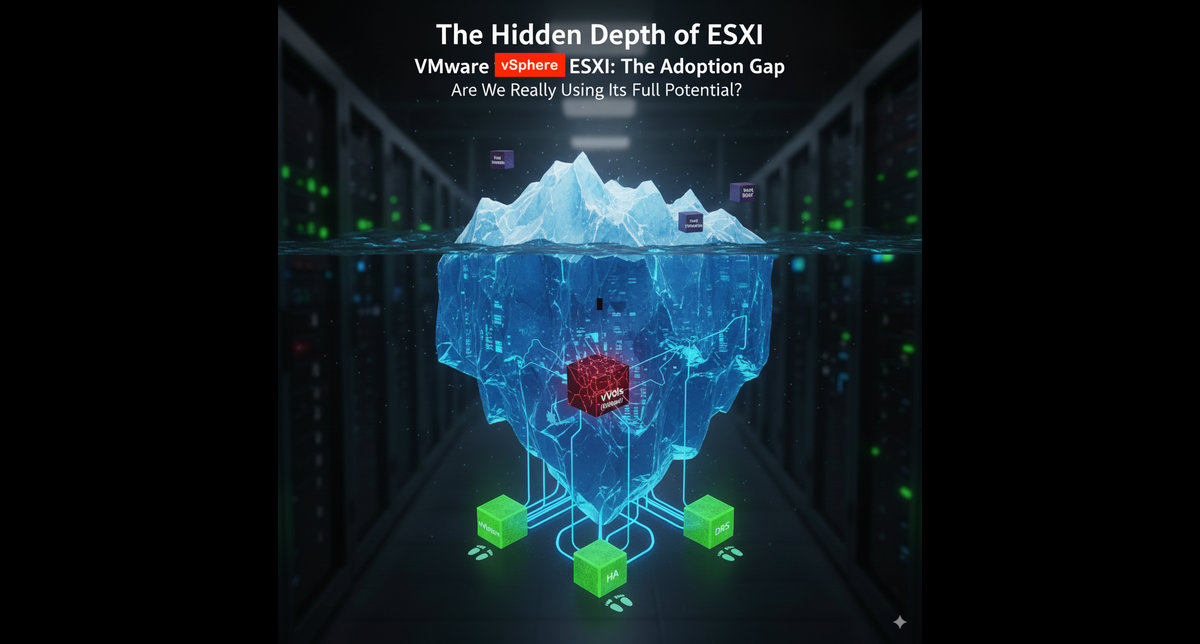VMware vSphere ESXi: Are We Really Using the Full Hypervisor?
In my last blog, I argued that going “halfway” with VMware Cloud Foundation (VCF) is the worst of both worlds: you pay premium pricing, but never capture ROI.

In my last blog, I argued that going “halfway” with VMware Cloud Foundation (VCF) is the worst of both worlds: you pay premium pricing, but never capture ROI.
This time, let’s zoom in on the foundation itself — the vSphere ESXi hypervisor — and ask an uncomfortable question: are we really using it to its full potential?
The Hidden Depth of ESXi
VMware’s vSphere Foundation 9.0 feature set shows just how deep ESXi runs:
- Core mobility & HA: vMotion (standard, cross-vCenter, long distance), Storage vMotion, HA, Fault Tolerance.
- Automation & lifecycle: Host Profiles, Auto Deploy, vSphere Lifecycle Manager (vLCM), Proactive HA, Distributed Resource Scheduler (DRS).
- Performance & scale: Enhanced vMotion Compatibility (EVC), Instant Clone, SR-IOV, GPU/vGPU scheduling, persistent memory, memory tiering.
- Security: VM encryption, vTPM, FIPS 140-2, TLS 1.3, Trust Authority.
- Kubernetes runtime: Supervisor Services, VM Service, Tanzu integrations.
- Networking: Distributed Switch, NIOC, Private VLANs, container networking with Antrea, load balancing for Supervisor.
- Operations: Aria Ops integrations, compliance templates (CIS, PCI, HIPAA), predictive capacity, cost analytics.
On paper, ESXi isn’t “just a hypervisor.” It’s a complete enterprise workload platform.
The Adoption Gap
And yet, when I talk to CIOs and architects, the story is remarkably consistent:
- Everyone uses vMotion, HA, and DRS.
- Some use Storage vMotion or Site Recovery Manager.
- Few leverage Host Profiles, Auto Deploy, or vLCM.
- Fewer still enable VM encryption, vTPM, or advanced GPU scheduling.
- Kubernetes runtimes? Often sidelined in favor of OpenShift, Rancher, or hyperscaler-managed K8s.
In practice, perhaps 30–40% of ESXi’s capabilities are widely consumed. The rest sit idle.
The vVols Lesson
Remember when vVols were promoted as the future of storage integration? Today, it’s being quietly retired. It’s a vivid reminder — in enterprise IT, today’s innovations can become tomorrow’s legacy lanes before we even fully traverse them.
The abrupt end of vVols is a reminder: features can disappear before most customers ever adopt them — while the vendor pivots to a new strategic focus. In this case, Broadcom’s bet is clearly on vSAN.
Why This Matters Now
If enterprises are underutilizing ESXi — the bedrock — then the promise of VCF becomes shaky. Broadcom’s economics assume you’re consuming:
- NSX for Networking & Security,
- vSAN for Storage,
- Aria for Automation & Operations,
- Tanzu for Modern Apps
But if ESXi itself is only partially used, how realistic is it to expect that your teams will embrace the full integrated stack?
The Bigger Industry Story
This underutilization isn’t new. It’s part of a larger pattern:
- Mainframes to x86: advanced system features underused before we moved on.
- On-prem to cloud: “lift and shift” ruled, real elasticity left untapped.
- Cloud to PaaS: platforms lagged until Kubernetes forced change.
- Now: Platform engineering and AI are redefining priorities, while open source (Kubernetes, Grafana, Prometheus, ELK) has matured into enterprise-grade alternatives.
We rarely maximize what we already have. Instead, we leap to the next platform wave, often repeating the cycle.
The CIO’s Call to Action
Before committing fully to VCF, ask:
- Which ESXi features are we actually using today?
- What remains untapped, and why? (skills, silos, vendor overlap, risk).
- Is our real value in extracting more from ESXi — or preparing for the next shift, where platform engineering, open source, and AI define the playbook?
Because in the end, VCF ROI isn’t just about licensing. It’s about whether your teams are truly consuming the platform you’ve already invested in.
Coming Next: Life Beyond VMware
This is the second article in my series on VMware Cloud Foundation realities for CIOs.
Next, I’ll explore migration strategies and life beyond VMware:
- Is moving off VMware even a card on the table?
- Which alternatives (Nutanix, OpenStack, Azure Stack HCI, OpenShift, Virtuozzo) are credible options?
- Can you reduce cost, retain flexibility, and still deliver the private/hybrid cloud your business demands?
Stay tuned.
Full reference blog: VMware Cloud Foundation: Why Going Halfway Will Hurt Your ROI
Written by Syed Waqar Uddin - Chief Cloud Architect specializing in platform engineering and cloud architecture.